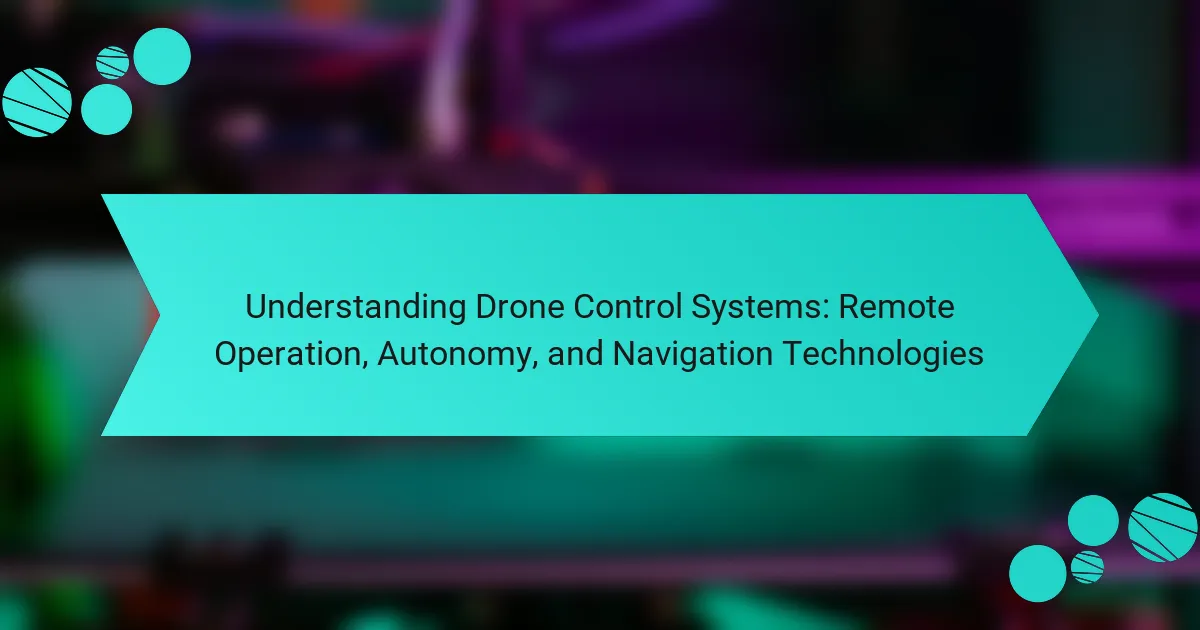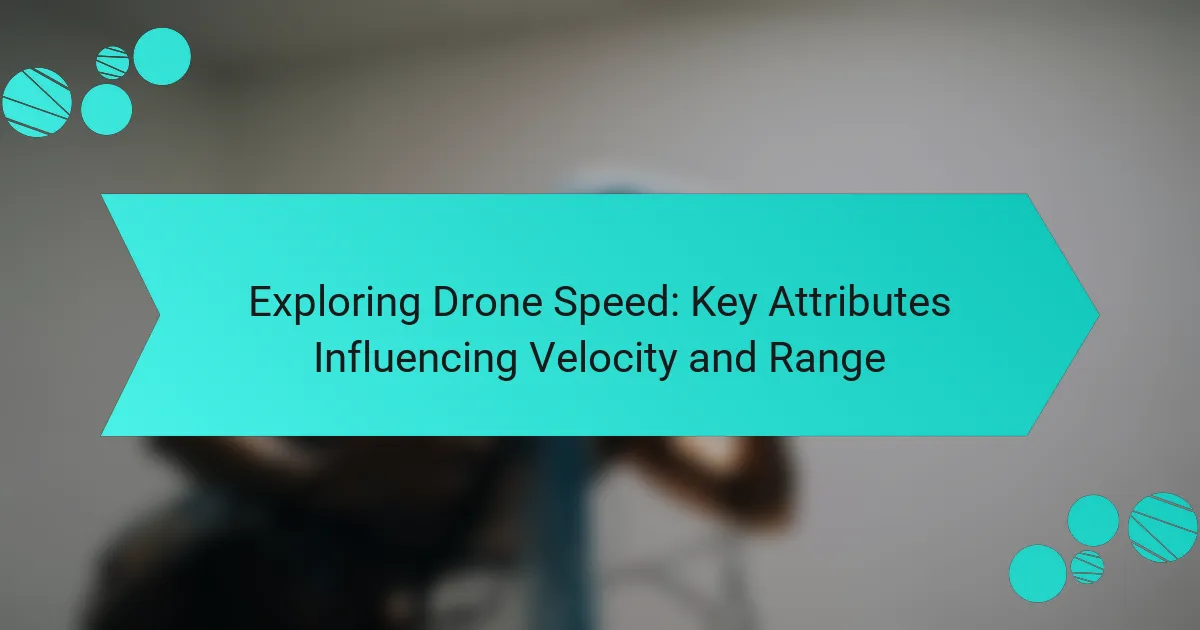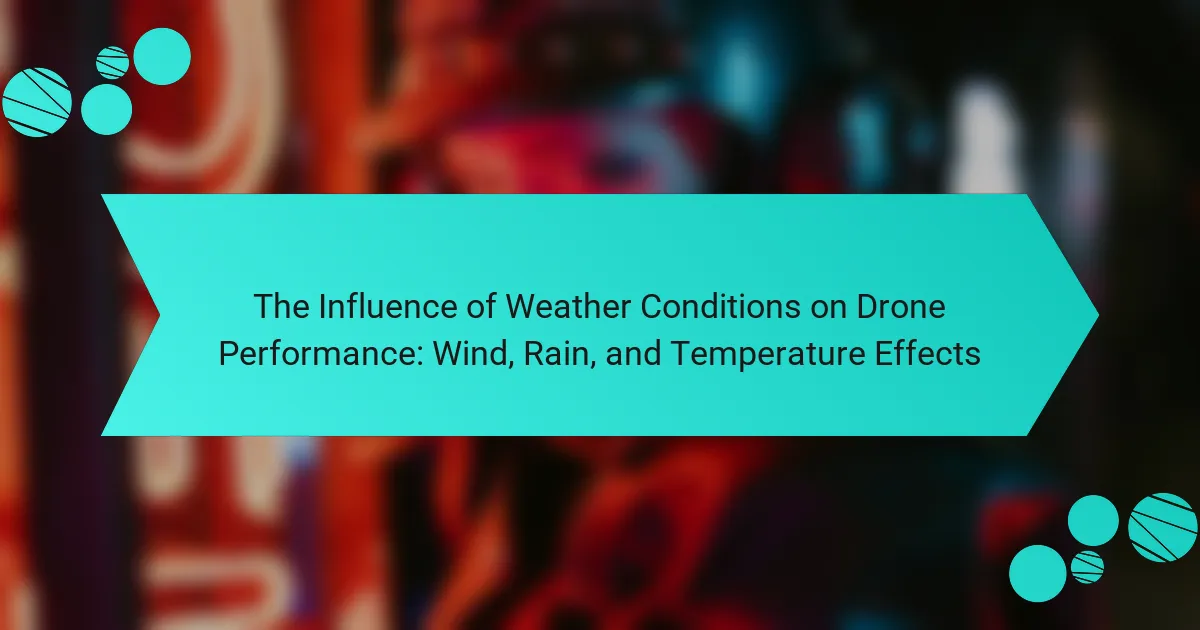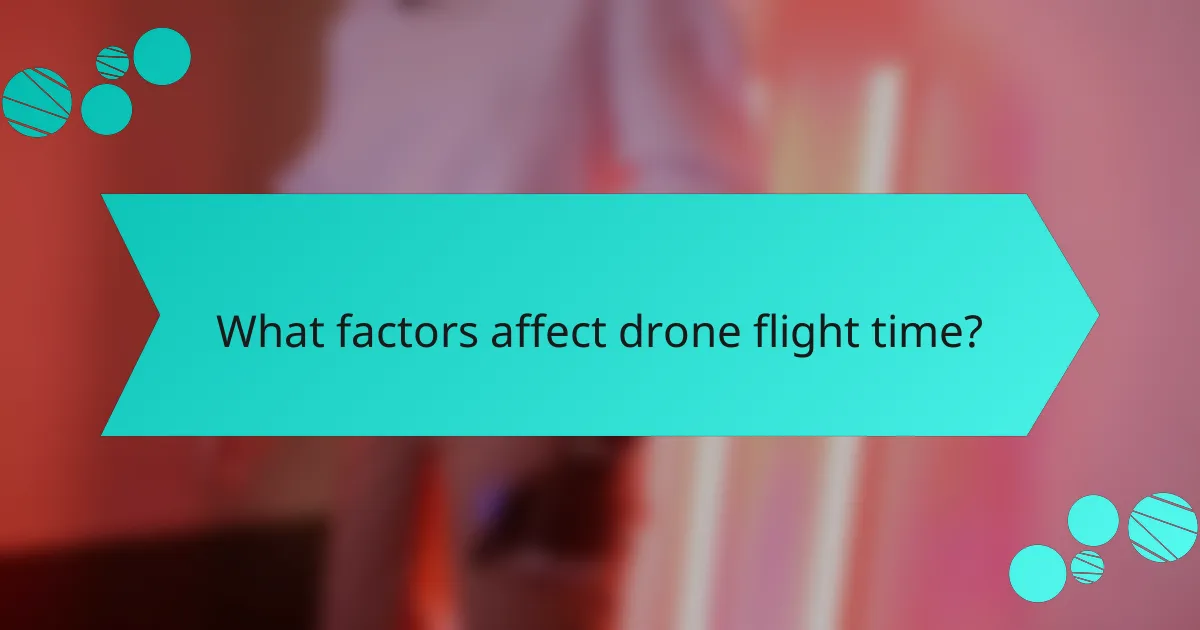
What factors affect drone flight time?
Drone flight time is primarily affected by battery capacity, weight, and environmental conditions. Battery capacity is measured in milliamp hours (mAh). A higher capacity allows for longer flight durations. Weight impacts flight time as heavier drones require more power to maintain lift. Environmental conditions, such as wind speed and temperature, also play significant roles. Strong winds can decrease flight efficiency and battery life. Additionally, the flight mode, such as sport or standard, influences power consumption. Lastly, the drone’s motor efficiency directly affects how long it can fly. Each of these factors collectively determines the overall flight time of a drone.
How does battery capacity influence flight duration?
Battery capacity directly influences flight duration in drones. Higher battery capacity allows for longer flight times. For instance, a drone with a 5000 mAh battery can typically fly for 25 to 30 minutes. In contrast, a drone with a 2000 mAh battery may only achieve 10 to 15 minutes of flight. This relationship is due to the amount of energy stored in the battery. More energy enables the drone’s motors to operate longer without depleting the power supply. Additionally, flight conditions and weight also affect how long a drone can stay airborne. However, the primary factor remains the battery capacity itself.
What is the relationship between mAh rating and flight time?
The mAh rating of a drone’s battery directly influences its flight time. A higher mAh rating indicates a larger battery capacity. This increased capacity allows the drone to draw more power for a longer duration. For instance, a 3000 mAh battery can provide flight time approximately 50% longer than a 2000 mAh battery, assuming other factors remain constant. Factors such as weight, motor efficiency, and flying conditions also affect flight time. However, the mAh rating serves as a key indicator of potential flight duration. Therefore, understanding this relationship helps users select batteries that meet their flight time needs.
How does battery type impact overall performance?
Battery type significantly impacts overall performance in drones. Different battery chemistries, such as lithium-ion and nickel-metal hydride, offer varying energy densities. Lithium-ion batteries typically provide higher energy density, resulting in longer flight times. For example, a lithium-ion battery can deliver up to 250 Wh/kg, compared to 100 Wh/kg for nickel-metal hydride batteries.
Additionally, battery discharge rates affect performance. Lithium polymer batteries can handle higher discharge rates, enhancing power output during demanding maneuvers. This capability leads to improved responsiveness and agility in flight.
Charging times also vary by battery type. Lithium-ion batteries generally charge faster than their counterparts, allowing for quicker turnaround between flights. This efficiency is crucial for commercial applications where downtime must be minimized.
In summary, battery type influences energy density, discharge rates, and charging times, all of which are critical to drone performance.
What role does weight play in drone flight time?
Weight significantly impacts drone flight time. Heavier drones require more power to maintain lift. Increased power demand drains the battery faster. A study by the University of Southern California found that for every additional gram of weight, flight time decreases by approximately 0.1%. This correlation highlights the importance of weight management in drone design. Lighter drones can achieve longer flight durations. Therefore, minimizing weight is crucial for optimizing drone performance and battery efficiency.
How does payload affect battery consumption?
Payload increases battery consumption in drones. Heavier payloads require more energy to maintain lift and stability. This leads to faster depletion of battery power. Studies show that adding weight can reduce flight time by up to 30%. For instance, a drone carrying a 500-gram payload may experience a significant drop in operational time compared to a lighter load. Increased drag from the additional weight also contributes to higher energy usage. Therefore, managing payload is crucial for optimizing battery life in drone operations.
What are the implications of drone design on weight and flight time?
Drone design significantly impacts weight and flight time. Lighter drones generally achieve longer flight times. This is because reduced weight allows for less power consumption during flight. Conversely, heavier drones often have shorter flight durations due to increased energy requirements. The materials used in drone construction, such as carbon fiber versus plastic, influence overall weight. Additionally, battery capacity plays a crucial role in determining flight time. For example, a drone with a higher mAh rating can sustain longer flights despite its weight. Therefore, balancing weight and battery power is essential for optimal performance.
How do environmental conditions influence drone performance?
Environmental conditions significantly influence drone performance. Weather factors like wind speed, temperature, and humidity affect flight stability and battery efficiency. High winds can cause drones to struggle with control, leading to increased energy consumption. Cold temperatures can reduce battery capacity, limiting flight time. High humidity can impact electronic components, potentially causing malfunctions. Additionally, altitude affects air density, which influences lift and propulsion efficiency. Research shows that drones can experience up to 30% reduced flight time in adverse weather conditions. Understanding these factors is essential for optimizing drone operations.
What effects do wind and temperature have on flight time?
Wind and temperature significantly affect flight time. Wind can either hinder or aid a drone’s progress. A headwind increases resistance, leading to longer flight times. Conversely, a tailwind can reduce flight duration by assisting forward motion. Temperature impacts battery efficiency and performance. Colder temperatures can decrease battery capacity, reducing flight time. Warmer temperatures can enhance battery performance but may risk overheating. Studies indicate that a 10°C drop in temperature can reduce battery life by up to 20%. Understanding these factors is crucial for optimizing drone operations.
How can pilots mitigate environmental impacts on battery life?
Pilots can mitigate environmental impacts on battery life by optimizing flight conditions and managing energy consumption. They should avoid flying in extreme temperatures, as both heat and cold can reduce battery efficiency. Maintaining a steady flight speed also helps conserve energy. Additionally, pilots should plan flight paths that minimize unnecessary altitude changes. Using energy-efficient flight modes can further extend battery life. Monitoring battery health and performing regular maintenance ensures optimal performance. These practices collectively enhance battery longevity and reduce environmental strain.
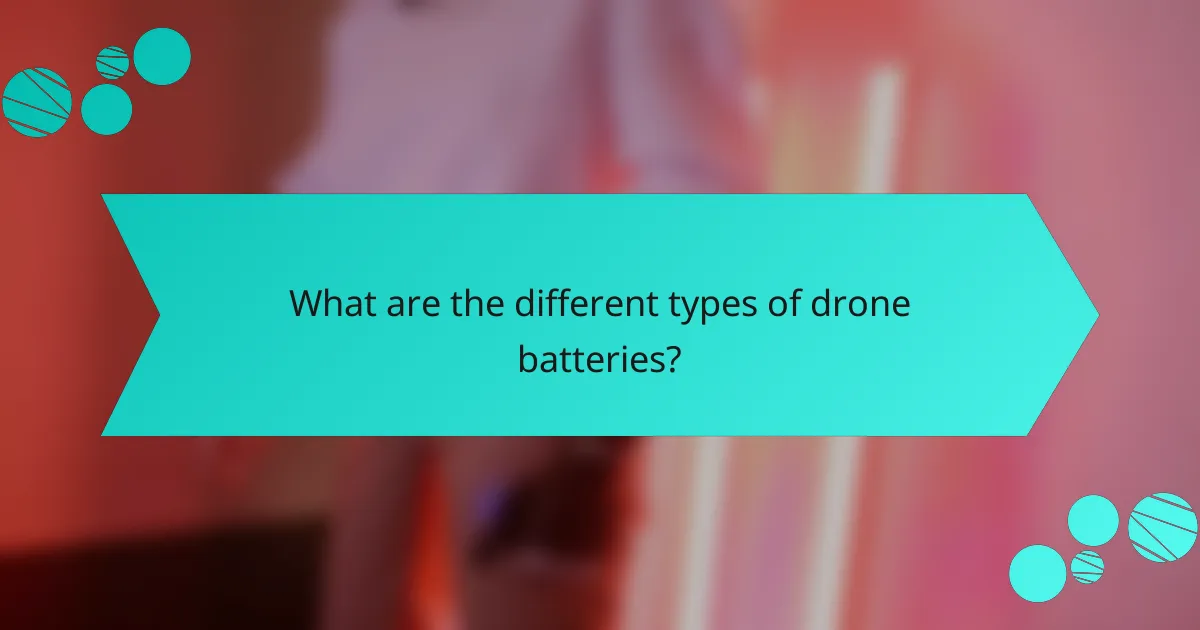
What are the different types of drone batteries?
The different types of drone batteries include Lithium Polymer (LiPo), Lithium-Ion (Li-Ion), Nickel-Metal Hydride (NiMH), and Lead Acid batteries. LiPo batteries are the most common type used in drones due to their high energy density and lightweight nature. They provide a good balance of power and weight, making them ideal for various drone applications. Li-Ion batteries are also popular as they offer longer life cycles and higher energy density compared to NiMH batteries. NiMH batteries are less commonly used but can be found in some consumer drones due to their robustness and lower cost. Lead Acid batteries are generally used in larger drones or for specific applications, as they are heavier and less efficient than other types.
What are the characteristics of LiPo batteries?
LiPo batteries are characterized by their lightweight and high energy density. They typically have a nominal voltage of 3.7 volts per cell. These batteries can provide high discharge rates, making them suitable for applications like drones. LiPo batteries are also known for their ability to maintain voltage levels under load. They come in various cell configurations, allowing for flexibility in energy capacity. Additionally, they require specific charging methods to ensure safety and longevity. LiPo batteries are sensitive to temperature and must be stored properly to prevent damage. The chemistry of LiPo batteries allows for a higher energy-to-weight ratio compared to other battery types.
How do LiPo batteries compare to other types in terms of flight time?
LiPo batteries generally provide longer flight times compared to other battery types like NiMH and NiCd. LiPo batteries have a higher energy density, allowing them to store more energy in a smaller size. This results in lighter drones that can fly for extended periods. For example, a typical LiPo battery can offer flight times of 10 to 30 minutes, depending on the drone’s weight and usage. In contrast, NiMH batteries typically yield shorter flight times, often around 5 to 15 minutes. The efficiency of LiPo batteries is further enhanced by their ability to deliver high discharge rates, which is crucial for the performance of drones during flight. This combination of higher energy density and discharge capabilities makes LiPo batteries the preferred choice for most drone enthusiasts seeking optimal flight time.
What safety considerations are there for using LiPo batteries?
Safety considerations for using LiPo batteries include proper charging, storage, and handling practices. Always use a compatible charger designed for LiPo batteries. Overcharging can lead to swelling, fire, or explosion. Store LiPo batteries in a cool, dry place away from flammable materials. Avoid puncturing or damaging the battery, as this can cause short circuits. Monitor the battery’s temperature during use; excessive heat indicates potential failure. Dispose of damaged or swollen batteries according to local regulations. Following these precautions minimizes risks associated with LiPo battery use.
What advantages do Li-ion batteries offer for drones?
Li-ion batteries offer several advantages for drones. They provide a high energy density, which allows for longer flight times. This is critical for applications such as aerial photography and surveying. Li-ion batteries also have a lightweight design, contributing to the overall efficiency of the drone. Their ability to maintain voltage levels throughout discharge ensures consistent performance. Furthermore, they have a low self-discharge rate, allowing drones to retain power when not in use. Additionally, Li-ion batteries support fast charging, minimizing downtime between flights. These features make them the preferred choice for modern drone technology.
How do Li-ion batteries affect overall drone performance?
Li-ion batteries significantly enhance overall drone performance. They provide high energy density, allowing drones to fly longer distances. This extended flight time is crucial for various applications, including aerial photography and surveying. Li-ion batteries also have a lighter weight compared to other battery types, improving the drone’s payload capacity. Additionally, they support faster charging times, enabling quick turnaround between flights. Their stable voltage output ensures consistent power delivery, which is essential for maintaining flight stability. According to a study by the International Journal of Electrical Engineering & Technology, drones equipped with Li-ion batteries can achieve up to 30% longer flight times than those using NiMH batteries. This demonstrates the critical role of Li-ion technology in optimizing drone performance.
What are the limitations of Li-ion batteries in drone applications?
Li-ion batteries have several limitations in drone applications. Their energy density, while high, still limits flight time. Typical Li-ion batteries provide around 150-250 Wh/kg. This results in shorter flight durations, often less than 30 minutes for consumer drones.
Temperature sensitivity also affects performance. Li-ion batteries can lose efficiency in extreme cold or heat. They may experience capacity loss and reduced power output under such conditions.
Additionally, charging times can be lengthy. Full charging can take 1-3 hours, which restricts operational flexibility.
Safety concerns exist as well. Li-ion batteries can catch fire or explode if damaged or improperly handled. This poses risks during transport and operation.
Lastly, degradation occurs over time. Li-ion batteries lose capacity after several hundred charge cycles. This reduces the overall lifespan and efficiency of the battery in drone applications.
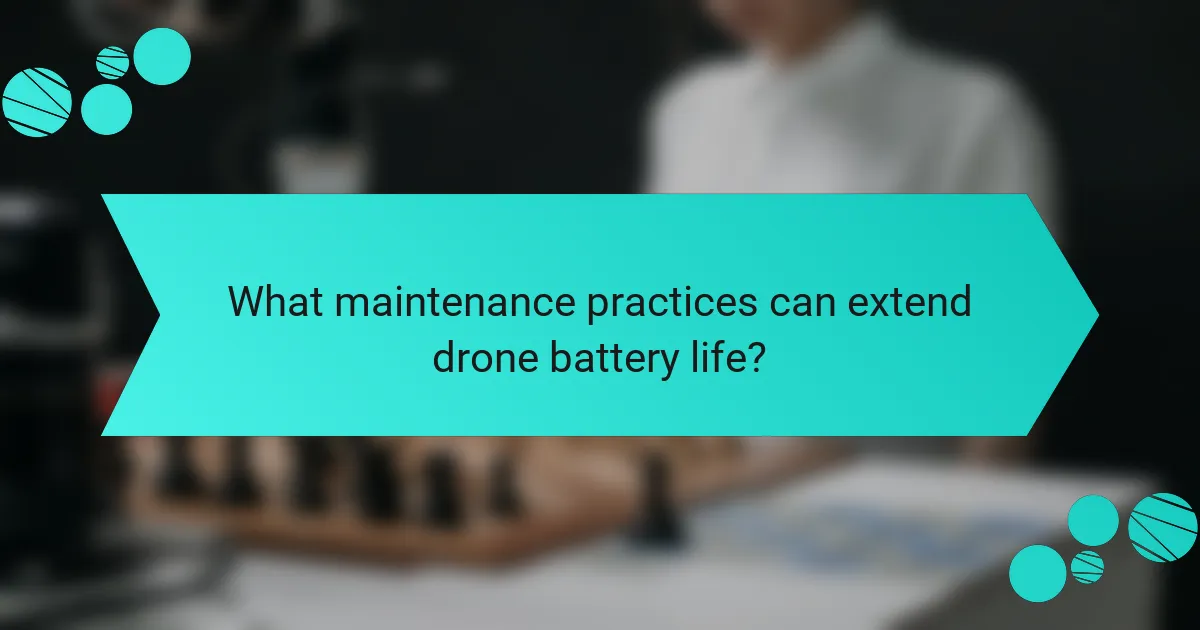
What maintenance practices can extend drone battery life?
Regularly calibrating drone batteries can extend their life. Calibration ensures accurate readings of battery levels. Keeping batteries at optimal temperatures between 20°C to 30°C prevents damage. Avoiding full discharges is crucial; maintain a charge level above 20%. Storing batteries in a cool, dry place reduces degradation. Cleaning battery contacts regularly ensures efficient power transfer. Using the correct charger prevents overcharging, which can harm battery cells. Following these practices can lead to longer battery lifespan and improved performance.
How does proper charging affect battery longevity?
Proper charging significantly enhances battery longevity. Charging a battery correctly prevents overheating and overcharging. Both conditions can damage battery cells and reduce lifespan. Lithium-ion batteries, commonly used in drones, benefit from being charged at optimal rates. For instance, charging at a slow rate can extend battery life compared to fast charging. Additionally, maintaining a charge level between 20% and 80% is ideal. This practice minimizes stress on the battery. Research indicates that following these charging guidelines can double the lifespan of lithium-ion batteries. Proper charging practices are essential for maximizing drone battery performance.
What are the best practices for charging drone batteries?
The best practices for charging drone batteries include using the manufacturer’s recommended charger. This ensures compatibility and safety during the charging process. Charge batteries in a cool, dry place to prevent overheating. Avoid charging batteries immediately after use; let them cool down first. Monitor the charging process to prevent overcharging, which can damage the battery. Use a fireproof charging bag for added safety. Additionally, keep the battery terminals clean to ensure proper connectivity. Following these practices can extend battery life and improve performance.
How can users avoid common charging mistakes?
Users can avoid common charging mistakes by following proper charging practices. Always use the manufacturer’s recommended charger to ensure compatibility. Avoid overcharging the battery, as this can damage its lifespan. Monitor the battery’s temperature during charging; excessive heat can indicate a problem. Store batteries in a cool, dry place when not in use to maintain their health. Charge batteries at room temperature for optimal performance. Finally, regularly inspect charging cables for wear and tear to prevent malfunctions. These practices help maximize battery life and performance.
What tips can improve overall drone efficiency during flight?
To improve overall drone efficiency during flight, optimize weight distribution and minimize payload. A balanced drone experiences less drag, enhancing flight stability. Maintain a steady flight speed to conserve battery power. Rapid acceleration and deceleration drain energy quickly. Utilize GPS and waypoint navigation for efficient route planning. This reduces unnecessary flight time and battery usage. Regularly update firmware to ensure optimal performance and efficiency. Recent studies indicate that drones with updated software exhibit improved flight times. Monitor battery health and avoid deep discharges to extend battery lifespan. Keeping batteries charged between 20% and 80% can enhance their longevity.
How can flight patterns influence battery usage?
Flight patterns significantly influence battery usage in drones. Different flight patterns can lead to varying energy consumption levels. For example, aggressive maneuvers like rapid ascents and sharp turns require more power. Conversely, steady, level flight conserves battery life.
Additionally, flight duration affects battery drain. Longer flights typically deplete batteries faster than shorter ones. The altitude and speed of flight also play crucial roles in energy efficiency. Higher altitudes may increase energy usage due to air density changes.
Studies show that optimized flight patterns can extend battery life. A research paper by Wang et al. (2020) highlights how efficient routing can enhance drone endurance. The findings suggest that planning flight paths can reduce unnecessary battery consumption.
What are the best strategies for optimizing drone flight time?
To optimize drone flight time, focus on weight reduction, battery management, and efficient flight patterns. Reducing the drone’s weight enhances its lift-to-weight ratio. This can be achieved by using lightweight materials and minimizing unnecessary accessories. Proper battery management involves ensuring batteries are fully charged and regularly maintained. Using high-capacity batteries can extend flight duration. Additionally, flying at optimal speeds and avoiding aggressive maneuvers can conserve energy. Research shows that maintaining a steady speed can increase flight time by up to 20%. Lastly, utilizing GPS and automated flight paths can improve efficiency, reducing time spent navigating.
The main entity of this article is drone flight time, which is influenced by several critical factors including battery capacity, weight, and environmental conditions. Key attributes such as battery type and flight mode also play significant roles in determining overall performance and duration. The article explores how battery capacity, measured in milliamp hours (mAh), directly correlates with flight time, while weight management and environmental conditions like wind and temperature further impact efficiency. Additionally, it examines different battery types, their characteristics, and best practices for optimizing battery life and drone performance.
